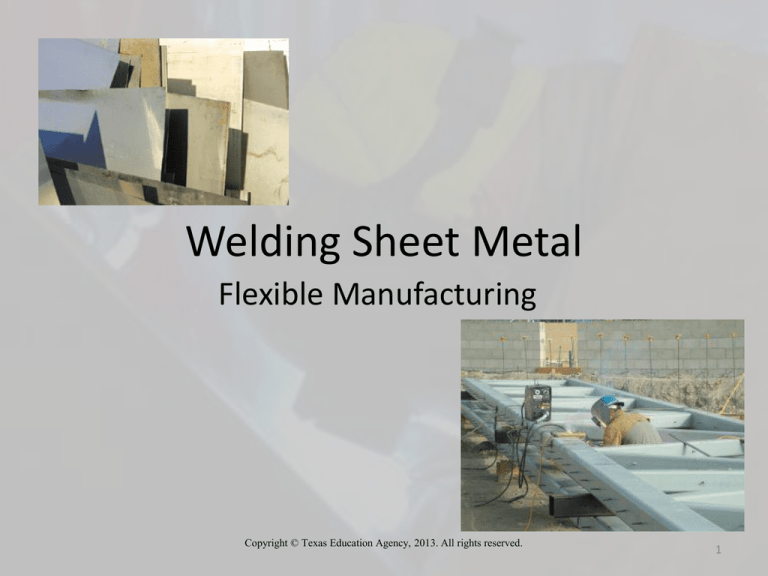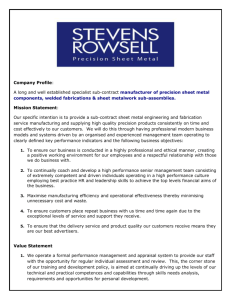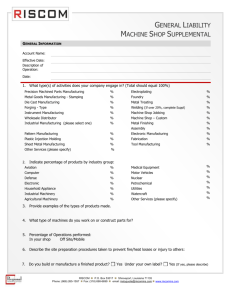
Welding Sheet Metal
Flexible Manufacturing
Copyright © Texas Education Agency, 2013. All rights reserved.
1
Sheet Metal
• There are many types of sheet
metals manufactured for
various applications.
• The sheet metal may be
developed to bend, stretch, or
to resist corrosion.
• The application will determine
what alloys are added to the
steel when making it.
Copyright © Texas Education Agency, 2013. All rights reserved.
2
History of Sheet Metal
• Sheet metal is formed when a hot steel ingot is
squeezed between a series of rollers.
• The rollers apply pressure and compress the
metal into a long, thin sheet.
Copyright © Texas Education Agency, 2013. All rights reserved.
3
Rolling Mill Animation
Copyright © Texas Education Agency, 2013. All rights reserved.
4
Hot Rolled vs. Cold Rolled
Hot Rolled
• Formed while hot
• Not uniform in
thickness
• Surface can be scaly
• Less expensive
Cold Rolled
• Formed when cold
• Uniform in thickness
• Surface is smooth
• Costs more than hot
rolled
• Surface can be grained
or textured
Copyright © Texas Education Agency, 2013. All rights reserved.
5
Sheet Stock in
Flexible Manufacturing
• Sheet stock used in a lab will be different gauges
of steel, and it could include materials such as
copper, aluminum, and brass.
Copyright © Texas Education Agency, 2013. All rights reserved.
6
Welding Sheet Metal
Copyright © Texas Education Agency, 2013. All rights reserved.
7
Oxy-fuel Process
Welding sheet metal is achieved by heating the
edges of the metal and adding a filler rod into the
weld pool.
Copyright © Texas Education Agency, 2013. All rights reserved.
8
Welding Sheet Metal
• The torch tip selected should provide the right
amount of heat to melt the metal and rod.
• If the tip has a large opening, the metal will heat
too fast, causing the puddle to be too hard to
control, which causes a poor weld.
Copyright © Texas Education Agency, 2013. All rights reserved.
9
Welding Sheet Metal
The weld joint should be tacked in a few places
before welding, to keep the joint from warping and
twisting.
Copyright © Texas Education Agency, 2013. All rights reserved.
10
Welding Coated Metal
• Zinc and other coated metals should be
welded with great caution.
• Weld only in a well-ventilated area.
Copyright © Texas Education Agency, 2013. All rights reserved.
11
Shielded Metal Arc Welding
on Sheet Metal
• Welding on thin sheet metals requires a smaller
diameter electrode and less amperage.
• When welding 1/16” thick sheets together, the
electrode used will be a 1/16” diameter rod with
the amperage set at 20-40 amps.
Copyright © Texas Education Agency, 2013. All rights reserved.
12
Shielded Metal Arc Welding
on Sheet Metal
• The amperage used should not
melt the metal too fast; this will
cause burn through.
• Overheating of the weld makes
it hard to control the weld pool
and causes a poor weld.
Copyright © Texas Education Agency, 2013. All rights reserved.
13
Shielded Metal Arc Welding
on Sheet Metal
• The welder will need to
tack-weld the joint in
different places to keep the
welded metal even.
• Overheating the metal
causes it to wrap, twist, or
spread apart.
Copyright © Texas Education Agency, 2013. All rights reserved.
14
Gas Metal Arc Welding
on Sheet Metal
• Gas metal arc-welding uses a
thin wire for the electrode.
• The electrode is fed through
the machine and out of a gun.
• The gun also has argon gas
piped to it.
• The gas envelopes the arc and
shields the molten puddle from
the atmosphere.
Copyright © Texas Education Agency, 2013. All rights reserved.
15
Gas Metal Arc Welding
on Sheet Metal
• The small diameter of the wire electrode makes
it easier to weld sheet metal.
• The amperage can be
set lower to keep from
burning through the
metal edges.
• The operator can set
the feed rate for the
wire electrode,
controlling the arc more easily.
Copyright © Texas Education Agency, 2013. All rights reserved.
16
Gas Metal Arc Welding
on Sheet Metal
• Used on
production lines
• Used in welding
and auto body
repair shops
Copyright © Texas Education Agency, 2013. All rights reserved.
17
Welding Electrodes
Copyright © Texas Education Agency, 2013. All rights reserved.
18
Common Types of Electrodes
• Different types of welding
have different styles of
electrodes.
• The electrode provides
the path for the current
to flow to the metal to
be welded.
Copyright © Texas Education Agency, 2013. All rights reserved.
19
Common Types of Electrodes
• Shielded metal-arc welding (SMAW) or “stick
welding” uses a metal rod coated with a flux.
• They have a number system that describes the
rods, tensile strength, coating, welding current,
and direction.
E6013
Copyright © Texas Education Agency, 2013. All rights reserved.
20
Common Types of Electrodes
• Gas metal arcwelding (GMAW) or
“MIG welding” uses a
thin wire loaded into
the machine’s feeder.
• The wire is sized by
diameter.
Copyright © Texas Education Agency, 2013. All rights reserved.
21
Common Types of Electrodes
• Gas Tungsten Arc
Welding(GTAW) or “TIG
welding” uses a
tungsten rod as the
electrode.
Copyright © Texas Education Agency, 2013. All rights reserved.
22
Common Types of Electrodes
• Oxygen Acetylene
(OAW) uses a metal
filler rod in the
welding process.
Copyright © Texas Education Agency, 2013. All rights reserved.
23
Resources
• Althouse, Turnquist, Bowditch, Bowditch,
Bowditch. (2013). Modern welding. Tinley
Park, Illinois: Goodheart-Willcox.
Copyright © Texas Education Agency, 2013. All rights reserved.
24








